The strange race to track down a missing billion years
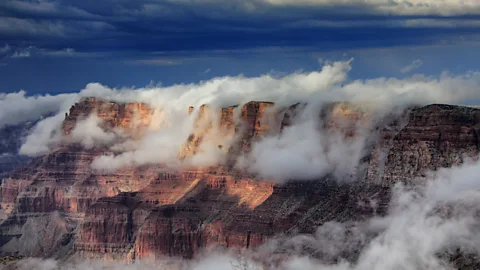 Getty Images
Getty ImagesA billion years have vanished from the geological record – and over 152 years after this was first discovered, scientists can't agree on why.
"FEARFUL DISASTER," read the headline on the front page of the Chicago Tribune on 3 July 1869.
The paper was referring to an incident involving a motley team of explorers led by the one-armed, self-taught geologist John Wesley Powell. Their mission was simple, though not easy – to travel 1,000 miles (1,609km) downstream from the banks of the Green River in Wyoming, cataloguing their finds as they went.
It had been some weeks since anyone had heard from the party, and public anxiety was mounting. Now a man claiming to be the sole survivor was speaking to the press. The last time he had seen them, he said, Powell had been standing on his boat, waving his hat in cheery farewell... just before the whole expedition plunged directly into some deadly rapids. Hours later, the narrator had found a lone carpet-bag floating down the river. It contained Powell's notebooks.
In the week that followed, the tragic news was widely circulated. But Powell's own wife was not convinced – and it turned out she was quite right. It soon became clear that the source had probably never even met Powell, let alone accompanied the expedition. His whole story was entirely made-up.
Meanwhile, the explorers' continued on their journey, entirely unaware of the bizarre scandal unfolding back home. And soon afterwards, the living, breathing Powell uncovered a disappearance of a very different kind – a vanishing that would baffle geologists for the next century and a half.
The lost years
Two months earlier, Powell's team – an unusual assortment of trappers, suspected fugitives, Native American scouts, former editors and ex-convicts – had burdened four wooden rowing boats with everything they needed for their journey, including a number of sophisticated scientific instruments. With a crowd of well-wishers gathered around them, they raised their little American flag and pushed off into the rush of water below.
The trip would span 10 months and require no small amount of courage to complete. There were almost daily run-ins with swirling rapids, precipitous waterfalls, and threatening rocks, and at one point, Powell had to sprint away from a 20-ft (6m) wide flash flood of red mud. The team lost an oar mere hours after departing – and in just over two weeks, one of their boats had been swept away. In all, only six out of 10 members of the original party would return home.
 Alamy
AlamyThe team first reached the Grand Canyon on 13 August 1869. By then, they had just a month's worth of rations remaining – some soggy apples, putrid bacon, musty flour and a sack of coffee – and many unknown dangers still lay ahead. The men were joking around as usual, but Powell wrote that to him "the cheer is sombre and the jests are ghastly".
Even in these desperate times, the team were awed by a steady carousel of wonders. All around, there were grand spires, ornately carved buttresses, and strange, angular pinnacles – imposing scenery on the scale of giants. Of all this, Powell was particularly struck by the cliffs, which he later described as a "library of the gods" – a place where colourful layers of rock formed the "stony leaves of one great book", in which they could read, line by line, how the universe was made.
At least, this is how it seemed at first. But then Powell discovered something odd in the bewildering height of the canyon walls.
You might also like:
Standing at the base of the cliffs and looking upwards, he could see a thick section of hard, crystalline rocks – mostly granite and schist (slate or shale that has been subjected to intense pressure), arranged in unusual vertical layers. Above this was a 1,000ft (305m) band of reddish sandstone, in the neat horizontal lines you would expect.
But here was the catch – by counting the layers of vertical crystalline rock, Powell estimated that this section should be 10,000ft (3,050m) thick. In reality, it measured just 500ft (152m). There were thousands of feet of missing rock – it had just vanished. He named this feature The Great Unconformity, and asked himself, "how can this be?".
Today geologists know that the youngest of the hard, crystalline rocks are 1.7 billion years old, whereas the oldest in the sandstone layer were formed 550 million years ago. This means there's more than a billion-year-gap in the geological record. To this day, no one knows what happened to the rocks in between.
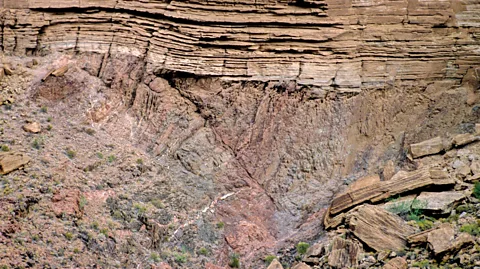 Alamy
AlamyA global anomaly
While the missing rock is particularly obvious in the Grand Canyon, the phenomenon is ubiquitous.
"It's one of these features that pretty much occurs under a lot of people's feet, when they don't even realise it," says Stephen Marshak, professor emeritus in the Department of Geology at the University of Illinois. He explains that in the centre of any continent, whether you're in the United States, Siberia or Europe, if you drill down far enough you'll hit the two layers of rock involved in this mysterious geological anomaly.
"And so what that means is that everywhere beneath you, that boundary exists – sometimes it's close to the surface and you can see it, sometimes it's kilometres below the surface, but it's always there, except in mountain ranges where it's been stripped away entirely," says Marshak. "And so it's widespread, and it's telling us a very, very important story about the Earth history."
As Marshak alludes, finding out what happened during, and led to, the missing billion years is no trivial matter. There are two reasons for this. The first is that it just so happens to have occurred immediately before another inexplicable event – the sudden proliferation in the diversity of life on Earth 541 million years ago.
The Cambrian explosion refers to an era when the oceans suddenly shifted from hosting a scattering of weird and unfamiliar creatures – such as triffid-like leaf-shaped animals and giant steamrollered ovals which continue to defy all efforts to categorise them – to an abundance of life, with many of the major taxonomic groups around today. It happened in the space of just 13-25 million years – an evolutionary twinkling of an eye.
The problem was first identified in the 1840s, and proved to be particularly challenging for Charles Darwin. He called it "inexplicable" and lamented in On the Origin of Species "…the difficulty of assigning any good reason for the absence of vast piles of strata rich in fossils beneath the Cambrian system is very great".
The second is that it's thought Earth underwent radical climate change during the lost years – possibly turning into a giant ball of ice, with an almost entirely frozen surface. Very little is currently known about how this "snowball Earth" formed, or how life managed to cling on.
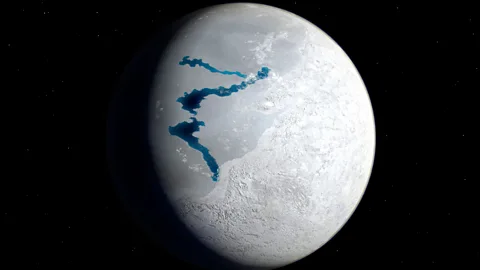 Alamy
AlamyHowever, if we knew what happened in this prehistoric dark age, perhaps we would find some answers to these thorny scientific puzzles.
"This is an interval in Earth's history when a lot is happening," says Rebecca Flowers, an associate professor in the Department of Geological Sciences at the University of Colorado, Boulder. "…And all of these events clearly are related in some form, so trying to disentangle the relationships among these different processes in this key interval of Earth's history, I think is pretty fundamental," she says.
Theory 1: the snowball
One idea about what caused the missing time hinges on what's happening on Earth's glaciers today. Take the second-largest ice body on the planet, the Greenland Ice Sheet, which covers around 80% of the country's surface – roughly 1.7 million sq km (656,000 sq miles).
Just like rivers, glaciers can also move – but very slowly. And as they do, they gradually scour away at the crust they're sitting on. If this continues for tens of thousands or even millions of years, eventually this erosion can abrade away significant quantities of rock. As a result, Greenland is riddled with the scars of its glacial history, such as deep valleys and dramatic fjords.
But while some parts of Greenland have been carved out by flowing ice, others have been protected by glaciers that were so hard and frigid, they didn't move at all – and kept the land underneath safely cocooned, free from any erosion. These areas have remained largely unchanged, and form the country's plateaus.
The former is what earth scientists call a "wet" glacier, while the latter is "cold", says C Brenhin Keller, an assistant professor in the department of Earth Sciences at Dartmouth College, New Hampshire.
Back when the Earth was a giant snowball, the theory goes, the same processes would have applied across the entire surface of the planet. So the only question is, how bitter was this era exactly – would the glaciers have been "wet" or "cold" – and could any amount of ice have eroded away a billion years of rock?
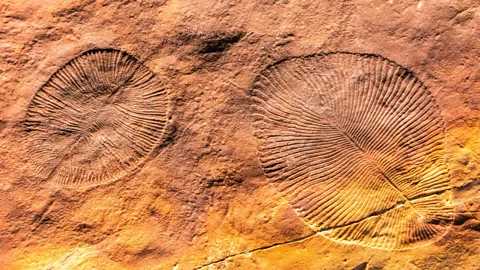 Alamy
AlamyBack in 2018, together with colleagues from a number of other universities, Keller attempted to answer this question. Based on a model developed by another group several years before, they assumed that snowball Earth would indeed have had a "wet" glacier on its surface, and it would have been surprisingly mobile.
That's because the global ice sheet would have collectively locked up so much water that the earth's sea level would have dropped dramatically. This in turn would have created a steeper gradient from the land to the sea, meaning that the glaciers on the earth's surface would be moving more rapidly – just as rivers speed up when they're running downhill.
Altogether, starting around 717 million years ago and ending around 580 million years ago, the team predicted that the frosty phase would have removed around 3-5 vertical km (1.9-3.1 miles) of rock – more than enough to account for The Great Unconformity.
"I think there's every reason to believe that this was fairly erosive," says Keller, though he points out that the amount of lost rock wouldn't have been the same everywhere "because ice is a very hit or miss driver of erosion." This might explain why there is more missing rock in some parts of the world than others.
However, this can't have been the full story, because it would still be another 40 million years before much new rock was laid down. "And I think what is going on there actually is essentially, you've made the crust hotter by just having chopped off the coldest part. That makes it more buoyant," says Keller. This pushed up the land and paved the way for yet more erosion – the higher it is, the more quickly it's eroded by ordinary weathering such as rain and wind.
Theory 2: the death of a supercontinent
Another possibility is that the culprit was the supercontinent Rodinia – a forgotten landmass that concentrated East Antarctica, India, Siberia, China, a large chunk of South America, North America and assorted bits of Africa in one place. It first assembled around a billion years ago, and broke up gradually, until 750 million years ago.
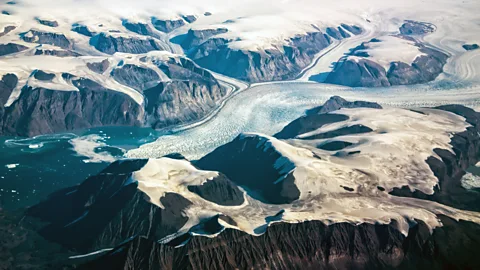 Alamy
Alamy"It basically amalgamated all of the crust on the world into a single giant continent," says Michael DeLucia, a PhD student in the department of Geology at the University of Illinois who authored a paper on the subject. He explains that most heat from the centre of the Earth is normally released via mountain ranges on the seafloor – oceanic ridges – which occur at the boundaries of tectonic plates. But when all the land was pushed together, there weren't as many of these, so Rodinia got quite hot.
"And of course, when things warm, they expand," says DeLucia. "So it was basically the expansion below the supercontinent that we think promoted this uplift event that caused around six to eight km (3.7-5 miles) of vertical uplift."
This not only accelerated the breakup of Rodinia, but may have erased the record of everything that happened in the preceding billion years – again, the land was higher and therefore more easily eroded.
According to this theory, Rodinia would have looked like a giant, hilly plateau for 200 million years – devoid of all life, which was still confined to the vast ocean that surrounded it. This was eventually eroded down to almost nothing. "And we see this erosion event across all current continents," says DeLucia.
But that wasn't quite the end of the story. The sheer amount of erosion involved would have changed the chemistry of the atmosphere and the oceans, leading to major climate change. It would have been the opposite of what's happening today – as rainwater scoured away the surface of the supercontinent, this would have released calcium ions, which then washed into the ocean to form calcium carbonate (the main ingredient in chalk). Essentially, the erosion trapped carbon dioxide in the ocean, locking it out of the atmosphere and cooling down the Earth.
In this scenario, the planet would have turned into a snowball after the billion years went missing, rather than before.
"This then perhaps even scraped off more sediments," says Marshak, who was also involved in the research, "which enhanced and amplified The Great Unconformity." In the end, the older layers of rock beneath the fragmenting Rodinia would have been exposed, ready to join up directly with the new sedimentary rock that was laid down once the climate stabilised again.
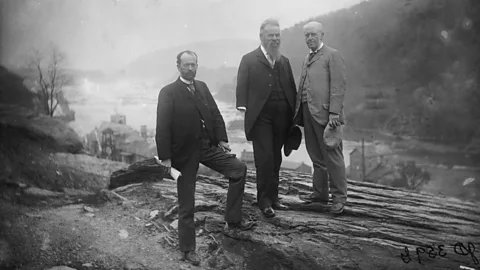 Alamy
AlamyWhichever way it happened, the erosion of unfathomable quantities of rock and transfer of these sediments to the oceans is thought to explain the proliferation of life that occurred immediately afterwards, during the Cambrian. It's particularly striking that – at a time when there would be more dissolved minerals in the ocean than ever – many of the new lifeforms that emerged had skeletons and shells that require calcium.
However, Marshak is keen to stress that the debate is ongoing. "There are a couple of issues that are still contentious about it, and are still subjects of research," he says.
Theory 3: a confusion of gaps
This brings us to the most recent idea.
There are only two possible ways for a billion years to go missing – either no rock was laid down, or it was all removed (or both).
Though The Great Unconformity is most visible at the Grand Canyon, it's also accessible at a number of other locations, one of which is the Canadian Shield, a vast area of exposed ancient rock that encircles Hudson Bay in the country's northeast. And here recent research revealed a twist.
"It appears that the major erosion at the Grand Canyon occurred prior to the snowball glaciation," says Flowers, who was involved in the research, "whereas in the Canadian shield it occurred later, during or perhaps after, the snowball Earth glaciations."
This suggests that the epic interruption in the geological record was not a single, discrete phenomenon – but instead is actually at least two mini-gaps, which look like one big one because they occurred at around the same time.
Then earlier this year, there was another surprise. Just over 150 years after Powell's fateful expedition, Flowers and colleagues went back to the Grand Canyon to do their own investigations. What they found was striking: even the lost billion years at the Grand Canyon may not have disappeared at the same time, and may instead have vanished in several separate events over the course of several hundred million years.
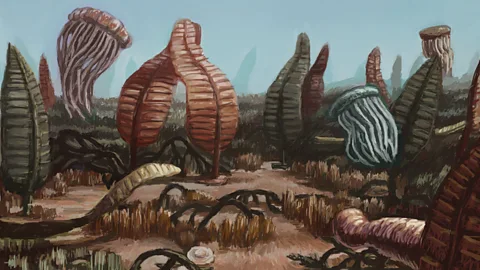 Alamy
Alamy"On these timescales, we're not really great at refining an age for missing time exactly," says Francis Macdonald, Professor of Geology at the University of California, Santa Barbara, who was also involved in the research. "And so the previous theory suggested that okay, it's all being formed once, with glaciation – but we're saying 'no it's been formed over hundreds of millions of years'… when you get better data, they [the unconformities] are not exactly correlative."
If the two sets of erased rock really are independent of each other, this suggests that they weren't caused by one extraordinary event like snowball earth after all. In this case, Flowers suggests that they might have been formed via tectonic processes which pushed vast quantities of the earth's crust upwards. There might have been no erosion either – it's possible that the higher altitude just made it difficult to deposit sediment, and therefore little rock was formed during this era in the first place.
An unsolved mystery
This is not quite the end, however. The debate continues – all the experts I spoke to emphasised the need for more data. And luckily this is likely to be forthcoming.
"I think there's [been] a renaissance of interest [in this geological enigma]," says Macdonald. A decade ago, there was relatively little research on The Great Unconformity and what caused it. But a surge of outlandish new theories – and the emergence of technologies capable of testing them – has transformed the field.
One major game-changer was a technique known as thermochronology, which involves extrapolating the history of rocks by measuring how their temperature has changed since they formed.
"So for example [with older methods], if somebody says that they dated a granite and it's 100 million years old, what they usually are referring to is the time at which it cooled from magma to become solid," says Marshak. With thermochronology, you aren't looking at when the rock formed, but roughly when it was pushed up to the Earth's surface – and this can tell you a lot about what was happening in our planet's deep past.
"This technique basically gave us a window to pull out the records of missing time," says Macdonald. Who knows what secrets they might reveal.
Zaria Gorvett is a senior journalist for BBC Future and tweets @ZariaGorvett
--
If you liked this story, sign up for the weekly bbc.com features newsletter, called “The Essential List”. A handpicked selection of stories from BBC Future, Culture, Worklife, and Travel, delivered to your inbox every Friday.
